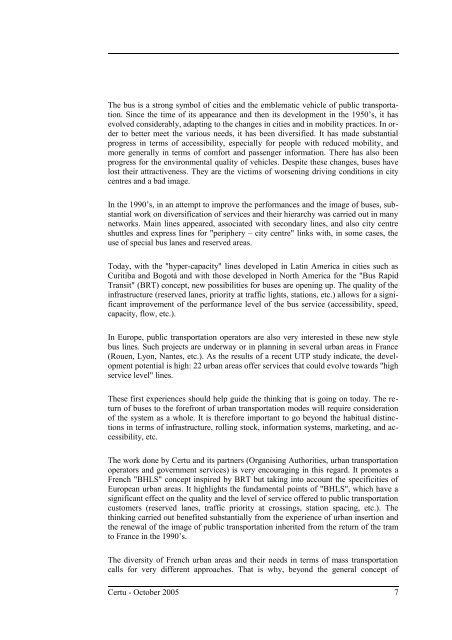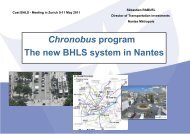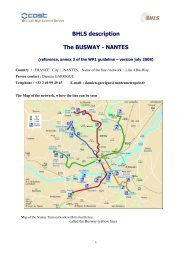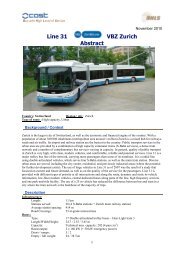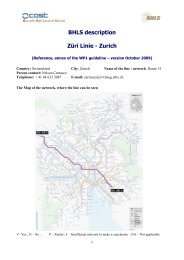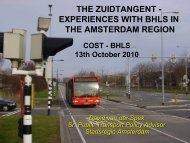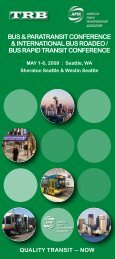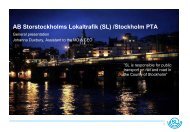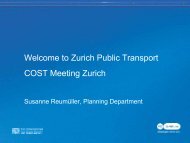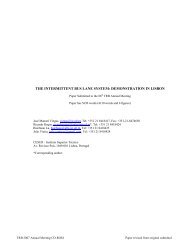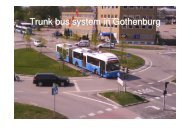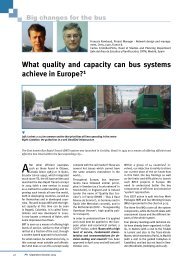BHLS_englishVersion_..
BHLS_englishVersion_..
BHLS_englishVersion_..
Create successful ePaper yourself
Turn your PDF publications into a flip-book with our unique Google optimized e-Paper software.
The bus is a strong symbol of cities and the emblematic vehicle of public transportation.<br />
Since the time of its appearance and then its development in the 1950’s, it has<br />
evolved considerably, adapting to the changes in cities and in mobility practices. In order<br />
to better meet the various needs, it has been diversified. It has made substantial<br />
progress in terms of accessibility, especially for people with reduced mobility, and<br />
more generally in terms of comfort and passenger information. There has also been<br />
progress for the environmental quality of vehicles. Despite these changes, buses have<br />
lost their attractiveness. They are the victims of worsening driving conditions in city<br />
centres and a bad image.<br />
In the 1990’s, in an attempt to improve the performances and the image of buses, substantial<br />
work on diversification of services and their hierarchy was carried out in many<br />
networks. Main lines appeared, associated with secondary lines, and also city centre<br />
shuttles and express lines for "periphery – city centre" links with, in some cases, the<br />
use of special bus lanes and reserved areas.<br />
Today, with the "hyper-capacity" lines developed in Latin America in cities such as<br />
Curitiba and Bogotá and with those developed in North America for the "Bus Rapid<br />
Transit" (BRT) concept, new possibilities for buses are opening up. The quality of the<br />
infrastructure (reserved lanes, priority at traffic lights, stations, etc.) allows for a significant<br />
improvement of the performance level of the bus service (accessibility, speed,<br />
capacity, flow, etc.).<br />
In Europe, public transportation operators are also very interested in these new style<br />
bus lines. Such projects are underway or in planning in several urban areas in France<br />
(Rouen, Lyon, Nantes, etc.). As the results of a recent UTP study indicate, the development<br />
potential is high: 22 urban areas offer services that could evolve towards "high<br />
service level" lines.<br />
These first experiences should help guide the thinking that is going on today. The return<br />
of buses to the forefront of urban transportation modes will require consideration<br />
of the system as a whole. It is therefore important to go beyond the habitual distinctions<br />
in terms of infrastructure, rolling stock, information systems, marketing, and accessibility,<br />
etc.<br />
The work done by Certu and its partners (Organising Authorities, urban transportation<br />
operators and government services) is very encouraging in this regard. It promotes a<br />
French "<strong>BHLS</strong>" concept inspired by BRT but taking into account the specificities of<br />
European urban areas. It highlights the fundamental points of "<strong>BHLS</strong>", which have a<br />
significant effect on the quality and the level of service offered to public transportation<br />
customers (reserved lanes, traffic priority at crossings, station spacing, etc.). The<br />
thinking carried out benefited substantially from the experience of urban insertion and<br />
the renewal of the image of public transportation inherited from the return of the tram<br />
to France in the 1990’s.<br />
The diversity of French urban areas and their needs in terms of mass transportation<br />
calls for very different approaches. That is why, beyond the general concept of<br />
Certu - October 2005 7


